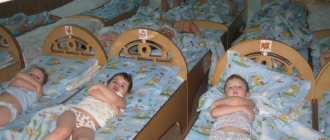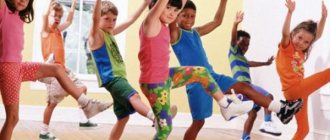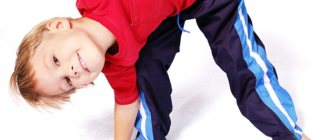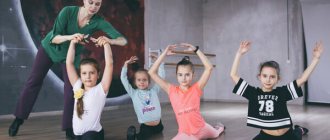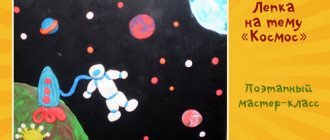Goals of eye gymnastics in a preschool institution
Visual gymnastics is one of the effective means of preventing eye diseases, as well as correcting existing problems. In kindergarten, it belongs to modern health-saving technologies (along with dynamic pauses, self-massage, breathing exercises, etc.).
It is interesting that the first exercises designed to maintain visual acuity were invented even before our era by Indian yogis. While creating complexes for the whole body, they did not forget about the eyes.
In a preschool institution, eye gymnastics is very important because it performs a number of tasks:
- General improvement of the visual system, prevention of various disorders in the functioning of the visual organs: strengthening the eye muscles, relieving tension, preventing fatigue, improving blood circulation in the eyes.
- It is an effective addition in the treatment of existing diseases: childhood myopia, farsightedness, astigmatism.
- Forms in pupils ideas about the importance of taking care of their health, in particular, about the organs of vision. The children learn about the value of vision.
- Has educational value. By performing visual exercises, children learn to navigate in space: they reinforce the concepts of “right” and “left,” “up” and “down,” and “turn.” In addition, performing gymnastics contributes to the development of coherent speech, enrichment of vocabulary, and reinforces familiar concepts about the structure of the world around us.
Visual gymnastics teaches preschoolers to take care of their eyes and understand the value of vision
Indeed, visual gymnastics is very important when working with modern preschoolers. Working as a kindergarten teacher, on Mondays I often talked with the children about what they did over the weekend. Many enthusiastically began to retell the content of the cartoon or computer game they had watched. In the preparatory group, some children even brought mobile phones and tablets with them to kindergarten, gathering a group of peers around them. All together they began to look at the screen with a flashing image. Of course, I stopped such “games”. By the way, it is interesting that according to the stories of many children, parents also spend a lot of time at home, straining their eyesight: TV, social networks, etc. (“Mom was on the phone all day”).
TV, computer and mobile phones from an early age have a detrimental effect on the vision of preschoolers
Are there any contraindications for doing the exercises?
If there are complications caused by myopia, some conditions may be aggravated by exercise. This:
- retinal detachment (increased blood circulation and mechanical impact are not allowed);
- eye infections (conjunctivitis, blepharitis);
- eye injuries;
- severe myopia.
For strabismus and amblyopia (the so-called “lazy eye”), standard exercises designed for myopia are also not used. There are special sets of eye exercises for them.
The exercises included in children's complexes for myopia have a certain focus. Some exercises are designed to reduce eye fatigue, others to strengthen the eye muscles, and others to improve blood circulation or accommodation. For example, some scientists suggest psycho-emotional causes of eye muscle tension in children.
Remember that the choice of a specific set of exercises for myopia should rest entirely with the ophthalmologist. In this case, the general physical and psycho-emotional state of the child, the health of his eyes and the degree of myopia, as well as the lifestyle and age of the young patient should be taken into account.
Before performing exercises, you should definitely undergo a diagnostic examination and consult with an ophthalmologist.
Types of visual gymnastics in preschool educational institutions
Several types of visual gymnastics are practiced in kindergarten:
- Without attributes (exercises are simply performed according to the teacher’s verbal instructions) and with objects and visual aids (children follow with their eyes a moving toy, “run” their eyes along the indicated trajectory, etc.).
- Preventive (aimed at preventing the development of eye diseases) and corrective (slows down the development of myopia, farsightedness, astigmatism, etc.).
- Passive (only exercises for the eyes) and active (combined with general developmental exercises, using the muscles of the arms, legs, back, etc.).
It is advisable for the teacher to conduct various types of eye gymnastics with preschoolers, alternating them wisely.
The benefits and harms of eye simulators
There is debate among patients and ophthalmologists about the benefits and harms of eye simulators. Doctors quite widely use simulators in pediatric vision restoration therapy. There are physiotherapy rooms in every eye clinic, and these methods are always used in a course of complex treatment.
Typically, the course includes vitamins and medications that improve blood flow to the head and vascular function. Therapeutic gymnastics and a large course of training on simulators. This gives good results in restoring vision in children. Between courses, many are prescribed occlusion - closing one eye at a time.
With regular treatment, which is usually every six months, therapy gives good results. But over time, as the eyes grow, vision recovery slows down. Adult ophthalmologists prescribe a completely different treatment, often surgical intervention.
To maintain results, it is recommended to use exercise machines and eye exercises. Which one is better to choose? Be sure to consult an ophthalmologist. The talk that exercise machines do not help is precisely because the device is chosen incorrectly or is not used correctly.
Methods of visual gymnastics
Visual gymnastics is carried out from a very early preschool age. You should do healthy exercises with your children two to three times a day. The duration of classes in the junior and middle groups is two to three minutes, in the senior group - four to five minutes.
When performing exercises, you must follow certain rules:
- Guys must stand or sit. At the same time, you should not strain your body.
- The head takes a fixed position (unless, of course, the gymnastics is active - it is not combined with head turns to strengthen the neck muscles).
- If some children wear glasses, they should be removed.
- Baby's breathing should be uniform and deep.
- The last exercise is best done by blinking, and after finishing the gymnastics, it is advisable for kids to stretch well.
Glasses must be removed during eye exercises.
To arouse the maximum interest of preschoolers in eye exercises, it should be carried out in a playful way and use imagery. For example, you can not just ask children to close their eyes tightly, but turn into eagle owls or cats who have just woke up. In addition, the children always like to do exercises accompanied by funny poems.
You can do visual gymnastics at any time: while walking, in your free time, or organically include it in any activity (cognition, speech development, productive activity). At the same time, the topic of exercise is connected with the topic of educational activities directly. For example, if children study insects, then the children can follow the flight of a toy bee with their eyes. If during the actual educational activity we are talking about transport, then you can offer an exercise with a short poem:
- They rush through the city from morning until night
- Cars of all brands, very beautiful.
- They will go left, right, around -
- Cars are free both night and day.
At the same time, children perform eye movements according to the text (left, right, circular), and at the end they blink.
If the lesson is associated with eye strain (productive activity), then eye gymnastics is carried out in the middle of the lesson. If the educational activity itself does not involve a load on the eyes (speech development, reading fiction), then a separate exercise for the eyes can be done in the second half of the lesson: the children will receive a kind of relaxation and will be able to get a little distracted.
You can find a lot of ideas for visual gymnastics while walking. For example, a teacher invites preschoolers to look down at the grass, then up at the sky, look for birds there, then back at the grass. In the warm season, you can watch a butterfly flapping its wings and offer to wave its eyelashes.
You can find a lot of ideas for visual gymnastics while walking
You can train children's eyes in your free time, in the morning or evening. The teacher offers the children ophthalmic simulators or specially alternates certain games: sorting small objects by shape or color (the muscles of the eye responsible for near vision work) and throwing balls into a basket or skittles (while the child looks into the distance). In sunny weather, you can use an ordinary mirror and chase sunbeams around the room: the kids will follow them with their eyes.
You can train your visual muscles even with the help of ordinary sunbeams
Features of working with preschoolers of different ages
When organizing gymnastics, it is important to take into account the age of preschoolers. For example, two-year-old children are unlikely to understand the verbal command “rotate with our eyes”: the teacher must use an object that the children will follow with their eyes. Moreover, it should not be an ordinary pencil, but a “magic wand” or a pointer with a picture or toy attached to it. An interesting idea is to put on a finger puppet.
Another effective way to interest a younger preschooler is phrases like “Can you do that? But I can do it!” After such words, inquisitive little ones are ready to repeat everything after the teacher.
Forcing a small child to do something if he is not interested is unacceptable and, moreover, will not bring any benefit.
As for the older preschool age, here you can motivate the children with an educational conversation: tell them about the structure of the human eye, about the need to care for it. Curious students will also be interested in learning the differences in the structure of the human eye and various animals (for example, a crocodile’s eyes are located on the sides of the head and have three eyelids). The teacher should discuss with children how harmful it is to watch cartoons and sit for long periods of time playing computer games. After such a conversation, preschoolers themselves will want to do useful exercises.
If, when conducting visual gymnastics with younger preschoolers, the teacher must demonstrate each exercise himself and do it together with the children, then at the senior level the teacher only needs to demonstrate the execution of the actions once. In the future, verbal instructions or reading a poetic text (if it accompanies the exercise) will be sufficient.
How to teach your child to do eye exercises regularly
Children may find it boring to do monotonous exercises. You won’t be able to get them interested in gymnastics by simply telling them the benefits it brings, especially if you have a preschool-age child.
It’s better to turn everything into a game: imagine that the child is the hero of some fairy tale, and he makes movements with his eyes to better see the dragons he has to fight, or with the help of his eyes he enters the code on the door of a secret laboratory. Tell him that there are no superheroes with poor eyesight, so they all do gymnastics several times a day. There can be many options, and they depend only on the parent’s imagination and the child’s hobbies.
Poems and songs written in such a way that for each line the child performs one or another movement with his eyes help a lot. You can use pictures and posters with various diagrams: let the child imagine that it is a labyrinth and use his eyes to move from one object on the poster to another. The choice of option here also depends on the age of the little patient and his preferences.
And, of course, you cannot captivate a child without a personal example. Young children, especially preschoolers, want to be like their parents and imitate them. If a baby sees that his mom or dad is doing exercises for his eyes, he will be more willing to join in and adopt this habit.
Examples of exercises
When conducting gymnastics with younger preschoolers, the exercises should be extremely simple, but at the same time entertaining. You can use the following options:
- "Pussy eyes." The teacher asks the kids to imagine themselves as kittens. Children open their eyes wide and then close them. After that they look up, down, to the side.
- "Swing". The teacher invites the children to play with their eyes on a swing: fly up high and then fall down (moving their eyes up and down).
- "Carousel". Circular movements with eyes.
- "Day and night". The child holds his finger in front of him at arm's length. At first he looks at him with both eyes, then only with the right one while the left one is closed and vice versa.
- "Hide and seek." The guys need to close their eyes tightly for a couple of seconds, and then open them for the same amount of time (the motivation is “you’re hiding and no one can see you”).
- "Clothespin." Using the thumbs and index fingers of both hands, you need to squeeze the skin between the eyebrows (as if holding it together with a clothespin).
- "Butterfly". The teacher invites preschoolers to blink their eyelashes, like a butterfly flaps its wings.
Starting from middle age, exercises should be more complicated:
- "What changed?" While walking, invite the children to look into the distance at the children from the neighboring playground or at the passers-by from the group window and remember their location. Then the kids close their eyes for about 10 seconds, and then say how the location of the people has changed.
- "Geometric figures". The teacher asks preschoolers to imagine a large circle, and then circle it with their eyes clockwise and counterclockwise. Similarly, you can “draw” a square, and then move your gaze from the upper right corner to the upper left, etc.
- “We make faces.” The teacher invites the children to portray an animal, for example, a hedgehog. At the same time, it is stipulated that he stretches his lips forward, and his eyes “run” left and right, then up and down.
- "Expansion of visual fields." The child places the index fingers of both hands directly in front of him. Each finger is watched by its own eye. Then the fingers slowly spread apart, and the eyes continue to follow them.
- "Pinocchio." The guys look at the tip of their nose. Then the teacher counts to 5 (in the senior group - up to 10, in the preparatory group - up to 20) and asks the children to imagine that their nose is growing. They should follow its tip with their eyes - it seems to be moving away from them. After this, preschoolers also observe its decrease.
- "Shooting with the eyes." The child suddenly turns his gaze in any direction and says “bang-bang.”
In addition, from a young age you can perform visual gymnastics to a poetic text. At first these are short works, then longer ones. You can use the following options:
Table: "Bump"
| One day in the fall there was a pine cone hanging in the forest in plain sight. The cone looked at everyone and hung quietly. | Look at the index finger of an outstretched hand |
| Moose said it was low | Downward eye movements |
| And the little bunny is high, | Eye movements upward |
| Squirrel said - close, | Movement of the eyes to the tip of the nose. |
| And the hedgehog is far away. | Eye movements into the distance. |
Table: "Vegetables"
| The donkey walks around, chooses, and doesn’t know what to eat first. | Circle your eyes |
| The plum is ripe at the top, | Look up |
| And nettles grow below, | Look down |
| On the left - beets, on the right - rutabaga, | Look left-right |
| On the left is a pumpkin, on the right is a cranberry, | Left - Right |
| Below is fresh grass, | Look down |
| On top there are juicy tops. | Look up |
| I couldn’t choose anything and collapsed on the ground without strength. | Close eyes |
Table: “Christmas tree”
| There is a big Christmas tree, this height. | View from bottom to top |
| It has large branches that are this wide. | View from left to right |
| There are even cones on the tree, | Look up |
| And below is the bear’s den. | Look down |
| The clubfoot sleeps there all winter and sucks his paw in the den. | Close your eyes, then blink 10 times |
The following examples refer to active visual gymnastics (it is accompanied by body movements) to a poetic text.
Table: "Rain"
| The first drop fell: drip-drip And the second ran: drip-drip | Tap your finger on your palm |
| We looked at the sky | Look up |
| The droplets began to sing drip-drip | Knock on the head |
| Our faces got wet, we wipe them | Rub your face and eyes gently |
| Shoes - look | Look down at your feet |
| They became wet | Point to feet with hands |
| Let's move our shoulders together and shake off all the droplets | Shake your shoulders |
| Let's run away from the rain | Running in place |
| Let's sit under a bush | To squat |
Table: "Spring"
| Everything has woken up from sleep, which means spring has come to us. | Sipping |
| The sun is getting warmer, let's go for a walk soon! | Throwing the fingers out of the fist while simultaneously spreading the arms to the sides |
| On the right - the first flowers appeared on the meadow. | The right arm is moved to the side while fixing the direction with the gaze |
| On the left is a fast stream from a hillock to a drip. | The left arm is moved to the side, fixing the direction with the gaze |
| We made a boat | Place your palms in front of your chest |
| They decided to let it into the stream. | Removing folded palms forward from yourself |
| Sail away, my little boat, straight to the blue river! | We wave our palms, saying goodbye to the boat |
| This is how fun it is to play and walk on a spring day! The earth breathes freshness, I will breathe “spring” too! | Light bouncing in place |
Table: "Cat"
| Now the window has opened, | Spread your arms to the sides |
| The cat went out onto the ledge. | They imitate the soft, graceful gait of a cat. |
| The cat looked up. | Looking up |
| The cat looked down. | Looking down |
| Here I turned to the left. | Looking left |
| She watched the flies. | The gaze traces the “fly” from the left shoulder to the right |
| She stretched, smiled and sat down on the ledge. | Children squat. |
| She turned her eyes to the right and looked at the cat. | They look straight |
| And covered them with her hands. | Cover your eyes with your hands |
Video: a teacher conducts visual gymnastics with preschoolers
Video: girl doing eye exercises (7 exercises)
Other options for eye gymnastics
Exercise No. 1
- The child's head should remain motionless while performing exercises.
- You can place multi-colored cardboard circles of different sizes in different corners of the room.
- The baby should look at each such circle 3-4 times for several seconds in turn, then close his eyes for 10 seconds and look at the circles again.
- You can repeat the exercise 3 times.
Exercise No. 2
- In this exercise, the baby must close and relax his eyelids for 10 seconds several times in a row.
- Then he should put his hands under his chin and look up and down 4 times, and then take a break for 10 seconds.
- After this, he needs to look left and right 4 times.
The benefits of such exercises will only come if they are repeated systematically, so you should not waste time on them.
Exercise No. 3
You can play “shooting with your eyes” with your child: sharply move your gaze with the child in an unexpected direction, loudly saying “bang-bang.” This game, although simple, is funny and fun. Also, everyone will be interested in grimaces and blinking as relaxing exercises; you can even arrange a competition between family members to see who can blink longer or whose grimace is funnier.
Exercise No. 4
Writing with your nose will be an exercise for your neck and eye muscles.
- In the game “Pinocchio Writes a Letter,” the child closes his eyes and draws an object in the air with his nose.
- The adult must guess what it was.
- Before the game, you should agree on what “airy” objects can be drawn (wave, square, circle).
- You should start with the simplest ones, gradually complicating the figure (bush, house, bird).
With the help of this game, not only vision is strengthened, but also intuition is developed.
Using visual aids during visual gymnastics
When performing visual gymnastics, visibility is of great importance. It helps to interest children and make exercises more effective. After all, in preschoolers (especially at a younger age), visual-figurative thinking predominates, and many exercises, especially such as rolling the eyes, turning the eyes, are much easier for them to do with a visual reference in front of them.
Many exercises are easier to perform when there is a reference point in front of your eyes.
The following types of visual aids are used to conduct gymnastics in kindergarten:
- Guide items. They are distributed to all children or the teacher shows the object to a group of children. In the first case, each preschooler holds a small object in front of him (for example, a hair tie with a butterfly, it is convenient to put it on his finger) and moves it according to the teacher’s instructions. At the same time, the gaze follows him. Such things are again selected according to the topic of the lesson (the mentioned butterfly elastic band will come in handy, for example, when studying the topic “Insects”). In any case, the object should be large enough and bright, not blending in color with the teacher’s clothes and the surrounding environment. The simplest version of such a visual reference is a colorful magic wand (pointer). You can also use finger puppets. You can attach a picture to the end of it. When the teacher shows the landmark, he places the kids with lower visual acuity closer to him, while the rest sit or stand behind.
- Scheme. Such manuals are intended for older preschoolers, because they are already developing abstract thinking. They show different types of eye exercises. Looking at the picture, the child can understand exactly how to perform the actions.
- Signal marks. They are designed for exercises when the gaze switches from a near point to a far point. A mark with a diameter of about 0.5 cm is attached to the window glass at eye level of the preschooler. The child stands very close to her (distance - approximately 20 cm). He should look at the landmark for a couple of seconds, and then turn his gaze to a distant point on the street. The teacher asks the preschooler to tell him what interesting things he sees there.
- Wall-mounted and ceiling-mounted ophthalmic simulators. This is a kind of trajectories along which children's eyes “run”. For example, from one animal or fairy-tale character you need to get to another along a bright (usually broken) path. At the same time, the child’s head and torso may move. Each track has its own color. Exercises are usually performed collectively.
- Individual ophthalmic simulators. They are outline pictures of many individual small elements - butterflies, leaves, Christmas trees, etc. (at an older age, these can be letters or numbers). The child should visually trace the outline; you can also help with your finger. In this case, the preschooler holds the picture in front of him at arm's length.
Photo gallery: visual aids for performing visual gymnastics
The signal mark is needed to switch gaze from a near point to a far point
The simulators are designed for individual work
The child moves the object according to the teacher’s instructions and follows it with his eyes
The schemes are designed to work with older preschoolers
Children should visually trace the path from one character to another
Video: preschoolers perform eye exercises (an exercise with a visual reference - a homemade flower)
The teacher can easily make almost all the attributes for visual gymnastics with his own hands. So, a simple but original guide is Cheburashka with moving eyes (it can be any other character). It is cut out of colored cardboard. With the help of such a toy, you can not only strengthen your eyesight, but also repeat mathematical concepts (“in which direction is the character looking?”).
Due to the slits, Cheburashka's eyes move
Even pupils of the younger group can repeat the eye movements of such a Cheburashka - it replaces the teacher’s demonstration.
When working with children, Cheburashka’s actions replace the teacher’s demonstration
Another example of a homemade manual is geometric shapes cut out of colored cardboard (all of them are different colors). They are mounted on the wall at a sufficient distance from each other. The teacher chaotically names the figures or their color, and the children must look from one object to another without turning their heads.
An interesting guide is “The Orchard”. The poster shows various fruits: they form circles (small ones inside larger ones). The teacher names a specific fruit, and preschoolers must circle the corresponding circle with their eyes.
Fruits are arranged in circles of different sizes
Visualization should also be used when working with parents. Special posters showing how to correctly perform visual gymnastics should be periodically placed in the health corner in the locker room. Moms and dads can look at them there, and they will definitely attract children's attention.
Using the poster, parents will be able to familiarize themselves with the rules for performing visual gymnastics
Multimedia aids
Preschoolers always really like multimedia aids for visual gymnastics. They are videos where various objects appear on the screen: fish in an aquarium, butterflies in a meadow, stars in the sky, etc. The kids’ task is to follow them with their eyes. All this happens to the accompaniment of pleasant music, causing extremely positive emotions in the children.
Video: sunshine
https://youtube.com/watch?v=LzbmJRaD4s8
Video: butterfly
Video: starry sky
Video: balloons
Video: geometric shapes
Video: in the depths of the sea
Video: watching the figures
Video: rainbow
Complex E.S. Avetisov, performed at school and at home
Designed to prevent myopia in school-age children. It helps strengthen the eye muscles and accommodative apparatus, improve the nutrition of eye tissue. Recommended for children with a genetic predisposition to myopia and young patients with the first signs of the disease. Avetisov’s set of exercises can be used to maintain visual acuity in children experiencing severe visual stress, as well as in cases of developed myopia. You should start the exercises with small loads, gradually increasing them over the course of a week.
A standard set of exercises for children can be “cut” in half on the first day of classes, then gradually, over the course of several days, bringing it to the desired level. Exercises should be performed regularly, without missing a day - otherwise the effect will be partial or absent altogether:
- Lean back in your chair, take a deep breath and bend forward to exhale. 5-6 repetitions.
- Lean back in your chair and close your eyes tightly for 5-6 seconds, then open them. Do 5-6 repetitions.
- Blink your eyes quickly for 15 seconds and 10 seconds without blinking. 3 - 4 repetitions.
- Sitting position, hands on the belt, turn your head to the right and look at the elbow of your right hand, then to the left and look at the elbow of your left hand. Initial position. 5-6 repetitions.
- Sitting position. Raise your eyes from the floor up to the ceiling. Rotate your eyes clockwise and counterclockwise - 6 rotations in each direction.
- Stretch your arms forward and look at your fingertips, raise your arms up as you inhale, watching your fingers without raising your head. Lower your arms as you exhale. 4-5 repetitions.
- Extend your hand in front of you, raising your thumb and fix your gaze on its tip for 3-5 seconds, then slowly bring your finger closer to your nose until it starts to double, without taking your gaze away from it and move your hand back to its previous position (up to 8 repetitions).
- Standing position. Slowly move your half-bent hand from right to left, fixing your gaze on the tip of the raised thumb and back. 10-12 repetitions.
- Close your eyes and use the tips of your index fingers to lightly massage them through your eyelids for 30 seconds.
During the period of mastering the complex, it is necessary to control that the child performs all movements correctly .
Exercises to complicate step 5 of the complex - “draw” geometric figures in space with your eyes: circle, square, triangle, vertical and horizontal figure eight.
